Luther, and the Reformation
Led by
Martin Luther, the religious revolution known as the Reformation shook the
supremacy of the Catholic Church in Europe and founded the beginnings of the
Protestant faith.
Art was
very closely connected with the beginnings of Protestantism. More than ever
before, pictures were used to spread the new religious ideas, and close
friendships developed between the artists and the reformers. Such was the case
with Lucas Cranach the Elder and Martin Luther, an association which lives on
today in Cranach's memorable portraits of the founder of the Protestant faith.
Martin
Luther was born in November 1483, in the town of Eisleben in present-day East
Germany. He received a good education, and in 1501 went to study at the
University of Erfurt where he gained a master's degree. In 1505, at his
father's wish, he began studying law, but during the summer he was caught in a
violent thunderstorm on the road near Erfurt and, prostrated by a flash of
lightning and in fear for his life, vowed to become a monk.
 Within
two weeks Luther honoured his promise and entered the Augustinian monastery at
Erfurt. For the next ten years or so he devoted himself to his theological
studies and to his promising academic career. In 1511, he was sent by his order
to the monastery at Wittenberg, and became professor of theology at the
university there the following year. It was in his lectures and sermons over
the next six years that the ideas which formed the basis of the religious
Reformation evolved.
Within
two weeks Luther honoured his promise and entered the Augustinian monastery at
Erfurt. For the next ten years or so he devoted himself to his theological
studies and to his promising academic career. In 1511, he was sent by his order
to the monastery at Wittenberg, and became professor of theology at the
university there the following year. It was in his lectures and sermons over
the next six years that the ideas which formed the basis of the religious
Reformation evolved.
A PERSONAL RELIGIOUS VISION
In
these early years, Luther's search for deeper spiritual understanding was
guided by his own personal temperament he was highly strung, emotional and
subject to bouts of depression and by the religious beliefs of the time. He
feared Hell, the Devil and the closeness of Judgement Day. Tormented by the
belief that God's justice was punitive, he looked to the Bible for reassurance,
and gradually developed his own interpretation of the righteousness of God the
doctrine of Justification by Faith alone. This doctrine was based on the belief
that salvation is given to the individual believer by God through His grace,
rather than as a reward for merit, which is inevitably tainted by sin, and
therefore deserving of retributive justice. Since faith is personal, the priest
was no longer necessary as an intermediary with God a premise which
automatically challenged the entire Church system.
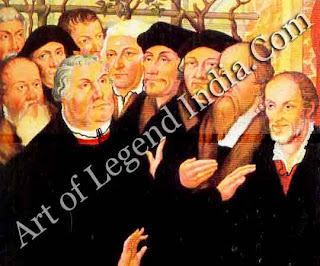
The
notion of Justification by Faith alone was the core of Luther's theology and,
as such, gave birth to Protestantism. But the revolution did not happen
overnight, and until 1517 Luther carried out his responsibilities in Wittenberg
seemingly unaware of the potential of his ideas. All this changed on 31 October
1517, when Luther translated his thoughts into action and nailed his 95 Theses
to the door of the Castle Church in Wittenberg, thus unleashing the religious
revolution now known as the Reformation.
CHURCH CORRUPTION
Luther
was furious about the sale of indulgences in Wittenberg. These were documents,
sold by the Church, which offered remission of penance for a cash payment. The
people flocked to hear indulgence sellers like John Tetzel, who attracted his
audiences with the jingle: 'As soon as the coin in the coffer rings, the soul
from purgatory springs!' Sentiments like these contradicted Luther's beliefs
about salvation, and he deeply resented the Church taking money from the poor
under what he understood to be false pretences. He criticized the system in the
95 Theses, but could not have foreseen the consequences of his action. What he
had intended as an academic debate rapidly became a national issue, and Luther
was thrust from obscurity into the limelight.
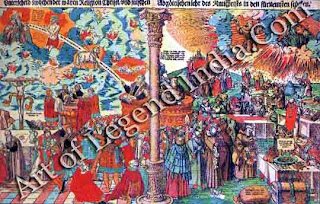 Luther's
protest immediately appealed to the Germans and aroused intense interest
throughout the Holy Roman Empire and beyond. For years resentment at the greed
of the Church had been growing, and now at last the people felt they had found
someone to champion their cause. Luther's ideas were translated into German and
printed pamphlets were sent all over the country. His skills as an author and
preacher enabled him to convince thousands. The movement could not be ignored.
Luther's
protest immediately appealed to the Germans and aroused intense interest
throughout the Holy Roman Empire and beyond. For years resentment at the greed
of the Church had been growing, and now at last the people felt they had found
someone to champion their cause. Luther's ideas were translated into German and
printed pamphlets were sent all over the country. His skills as an author and
preacher enabled him to convince thousands. The movement could not be ignored.
The
Church attempted to silence Luther, but reacted too slowly. Theologians first
attacked Luther's doctrines in the autumn of 1518. Thereafter the Church
continually called for Luther to recant, but he refused to do so, believing in
the truth of his doctrines. It became increasingly obvious that Luther's
challenge was not a harmless call for reform. His doctrine opposed the entire
theological basis of the Catholic Church and he found himself on a collision
course with its authorities.
By
1520, the Church leaders realized that they had to take action, and in October
Luther was sent a bull of excommunication. Fortified by the support of
thousands, from princes to peasants, Luther ignored the Pope's message and
defiantly set light to a bonfire made from the papal bull and r theological
books. The break with the Church was .E now irreparable. In January 1521,
Luther was finally excommunicated.
THE DIET OF WORMS
A
broadly based movement such as the Reformation could not distance itself
entirely from politics. Luther was now banned by the Church, but his
relationship with the secular authorities also had to be regularized. To be
effective, the papal ban had to be reinforced by an imperial edict. Thus it was
that the new emperor, Charles V, found Church reform to be the most urgent
issue facing him at the Imperial Diet of Worms in the spring of 1521. Charles
invited Luther to defend himself at the Diet and, on 16 April 1521, the
Reformer arrived in triumph at Worms, to streets filled with thousands of
cheering supporters. The following evening he appeared for the first time
before the Diet and was asked to recant.
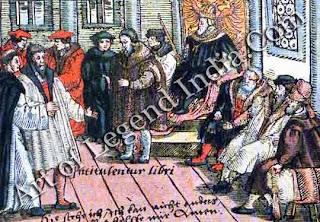 The
next day, in a packed hall, Luther again faced the Emperor. Again he was
questioned about his books, and had prepared a reply. He spoke first in German,
then in Latin, using no notes. Luther acknowledged the writings as his own and
justified them on the basis of truth, as they were grounded in the Word of God.
He finished with the plea: 'Here I stand. I cannot do otherwise. God help me.
Amen.' The Emperor replied: 'A single friar who goes counter to all Christianity
for a thousand years must be wrong.
The
next day, in a packed hall, Luther again faced the Emperor. Again he was
questioned about his books, and had prepared a reply. He spoke first in German,
then in Latin, using no notes. Luther acknowledged the writings as his own and
justified them on the basis of truth, as they were grounded in the Word of God.
He finished with the plea: 'Here I stand. I cannot do otherwise. God help me.
Amen.' The Emperor replied: 'A single friar who goes counter to all Christianity
for a thousand years must be wrong.
Events
would prove the ruler wrong. Although the Diet issued an edict against Luther,
the authorities were powerless to act. Luther's ideas had generated such
excitement that to punish Luther would risk revolt. Some even feared for
Luther's safety, and immediately after the Diet he was 'kidnapped' by his own
followers and 'imprisoned' in the Wartburg Castle until the situation was
calmer. All future attempts by the Catholic Church to deal with the Lutheran
threat proved futile. Luther had triumphed at Worms, and the Protestant
religion had come into being.
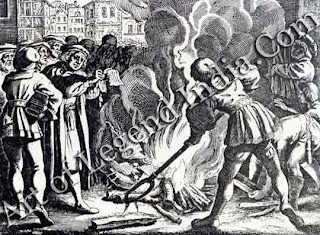 The
remaining years of Luther's life were ones of consolidation for Protestantism.
There were high points such as the formulation of the Confession of the
Lutheran faith at Augsburg in 1530 and low points, particularly the crisis
caused by the Peasant War of 1525, when extremists in the evangelical party
incited the peasants to rebel against their masters: Luther's advice to settle
grievances peaceably was disregarded and the peasants were savagely suppressed.
Luther himself found personal happiness in 1525, when he broke his monastic
vows and married a former nun called Katherine von Bora.
The
remaining years of Luther's life were ones of consolidation for Protestantism.
There were high points such as the formulation of the Confession of the
Lutheran faith at Augsburg in 1530 and low points, particularly the crisis
caused by the Peasant War of 1525, when extremists in the evangelical party
incited the peasants to rebel against their masters: Luther's advice to settle
grievances peaceably was disregarded and the peasants were savagely suppressed.
Luther himself found personal happiness in 1525, when he broke his monastic
vows and married a former nun called Katherine von Bora.
He
became a happy family man, content to write copiously and to preach, but was
concerned also to steer his new creed through its early years. This religious
genius, whose ideas had seized the popular imagination, died in February 1546,
in Eisleben. Rarely has the course of history been altered so effectively by
the actions of one man as it was by those of Martin Luther.
Writer
– Marshall Cavendish
 Within
two weeks Luther honoured his promise and entered the Augustinian monastery at
Erfurt. For the next ten years or so he devoted himself to his theological
studies and to his promising academic career. In 1511, he was sent by his order
to the monastery at Wittenberg, and became professor of theology at the
university there the following year. It was in his lectures and sermons over
the next six years that the ideas which formed the basis of the religious
Reformation evolved.
Within
two weeks Luther honoured his promise and entered the Augustinian monastery at
Erfurt. For the next ten years or so he devoted himself to his theological
studies and to his promising academic career. In 1511, he was sent by his order
to the monastery at Wittenberg, and became professor of theology at the
university there the following year. It was in his lectures and sermons over
the next six years that the ideas which formed the basis of the religious
Reformation evolved.  Luther's
protest immediately appealed to the Germans and aroused intense interest
throughout the Holy Roman Empire and beyond. For years resentment at the greed
of the Church had been growing, and now at last the people felt they had found
someone to champion their cause. Luther's ideas were translated into German and
printed pamphlets were sent all over the country. His skills as an author and
preacher enabled him to convince thousands. The movement could not be ignored.
Luther's
protest immediately appealed to the Germans and aroused intense interest
throughout the Holy Roman Empire and beyond. For years resentment at the greed
of the Church had been growing, and now at last the people felt they had found
someone to champion their cause. Luther's ideas were translated into German and
printed pamphlets were sent all over the country. His skills as an author and
preacher enabled him to convince thousands. The movement could not be ignored.  The
next day, in a packed hall, Luther again faced the Emperor. Again he was
questioned about his books, and had prepared a reply. He spoke first in German,
then in Latin, using no notes. Luther acknowledged the writings as his own and
justified them on the basis of truth, as they were grounded in the Word of God.
He finished with the plea: 'Here I stand. I cannot do otherwise. God help me.
Amen.' The Emperor replied: 'A single friar who goes counter to all Christianity
for a thousand years must be wrong.
The
next day, in a packed hall, Luther again faced the Emperor. Again he was
questioned about his books, and had prepared a reply. He spoke first in German,
then in Latin, using no notes. Luther acknowledged the writings as his own and
justified them on the basis of truth, as they were grounded in the Word of God.
He finished with the plea: 'Here I stand. I cannot do otherwise. God help me.
Amen.' The Emperor replied: 'A single friar who goes counter to all Christianity
for a thousand years must be wrong. The
remaining years of Luther's life were ones of consolidation for Protestantism.
There were high points such as the formulation of the Confession of the
Lutheran faith at Augsburg in 1530 and low points, particularly the crisis
caused by the Peasant War of 1525, when extremists in the evangelical party
incited the peasants to rebel against their masters: Luther's advice to settle
grievances peaceably was disregarded and the peasants were savagely suppressed.
Luther himself found personal happiness in 1525, when he broke his monastic
vows and married a former nun called Katherine von Bora.
The
remaining years of Luther's life were ones of consolidation for Protestantism.
There were high points such as the formulation of the Confession of the
Lutheran faith at Augsburg in 1530 and low points, particularly the crisis
caused by the Peasant War of 1525, when extremists in the evangelical party
incited the peasants to rebel against their masters: Luther's advice to settle
grievances peaceably was disregarded and the peasants were savagely suppressed.
Luther himself found personal happiness in 1525, when he broke his monastic
vows and married a former nun called Katherine von Bora. 
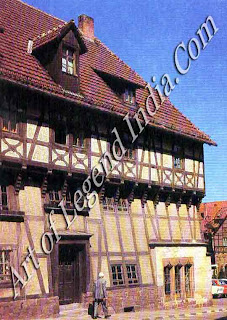

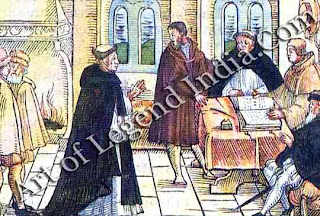










0 Response to "German Great Artist Lucas Cranach - Luther, and the Reformation"
Post a Comment